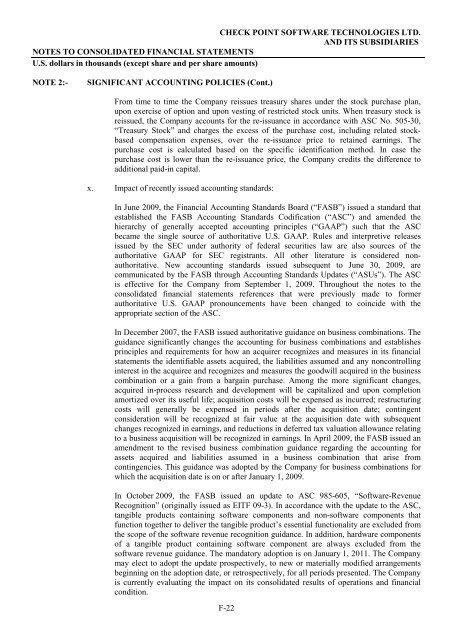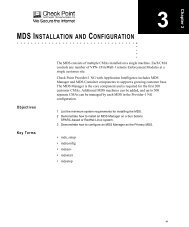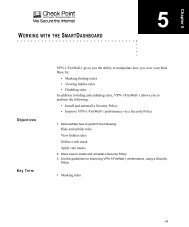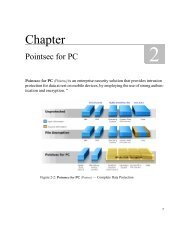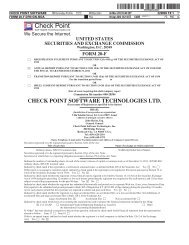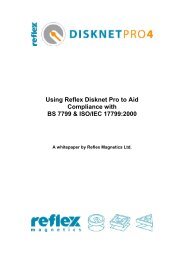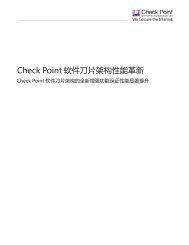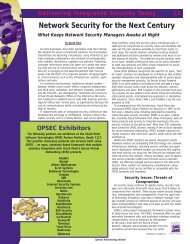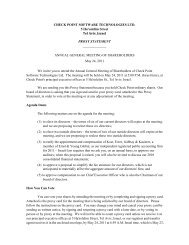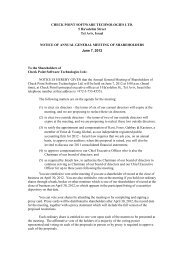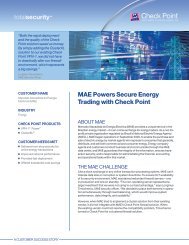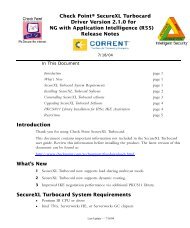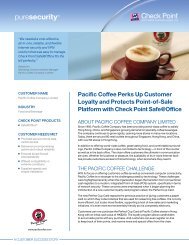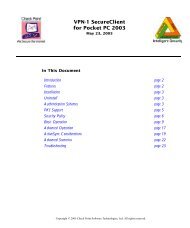FORM 20-F - Check Point
FORM 20-F - Check Point
FORM 20-F - Check Point
Create successful ePaper yourself
Turn your PDF publications into a flip-book with our unique Google optimized e-Paper software.
CHECK POINT SOFTWARE TECHNOLOGIES LTD.<br />
AND ITS SUBSIDIARIES<br />
NOTES TO CONSOLIDATED FINANCIAL STATEMENTS<br />
U.S. dollars in thousands (except share and per share amounts)<br />
NOTE 2:- SIGNIFICANT ACCOUNTING POLICIES (Cont.)<br />
From time to time the Company reissues treasury shares under the stock purchase plan,<br />
upon exercise of option and upon vesting of restricted stock units. When treasury stock is<br />
reissued, the Company accounts for the re-issuance in accordance with ASC No. 505-30,<br />
“Treasury Stock” and charges the excess of the purchase cost, including related stockbased<br />
compensation expenses, over the re-issuance price to retained earnings. The<br />
purchase cost is calculated based on the specific identification method. In case the<br />
purchase cost is lower than the re-issuance price, the Company credits the difference to<br />
additional paid-in capital.<br />
x. Impact of recently issued accounting standards:<br />
In June <strong>20</strong>09, the Financial Accounting Standards Board (“FASB”) issued a standard that<br />
established the FASB Accounting Standards Codification (“ASC”) and amended the<br />
hierarchy of generally accepted accounting principles (“GAAP”) such that the ASC<br />
became the single source of authoritative U.S. GAAP. Rules and interpretive releases<br />
issued by the SEC under authority of federal securities law are also sources of the<br />
authoritative GAAP for SEC registrants. All other literature is considered nonauthoritative.<br />
New accounting standards issued subsequent to June 30, <strong>20</strong>09, are<br />
communicated by the FASB through Accounting Standards Updates (“ASUs”). The ASC<br />
is effective for the Company from September 1, <strong>20</strong>09. Throughout the notes to the<br />
consolidated financial statements references that were previously made to former<br />
authoritative U.S. GAAP pronouncements have been changed to coincide with the<br />
appropriate section of the ASC.<br />
In December <strong>20</strong>07, the FASB issued authoritative guidance on business combinations. The<br />
guidance significantly changes the accounting for business combinations and establishes<br />
principles and requirements for how an acquirer recognizes and measures in its financial<br />
statements the identifiable assets acquired, the liabilities assumed and any noncontrolling<br />
interest in the acquiree and recognizes and measures the goodwill acquired in the business<br />
combination or a gain from a bargain purchase. Among the more significant changes,<br />
acquired in-process research and development will be capitalized and upon completion<br />
amortized over its useful life; acquisition costs will be expensed as incurred; restructuring<br />
costs will generally be expensed in periods after the acquisition date; contingent<br />
consideration will be recognized at fair value at the acquisition date with subsequent<br />
changes recognized in earnings, and reductions in deferred tax valuation allowance relating<br />
to a business acquisition will be recognized in earnings. In April <strong>20</strong>09, the FASB issued an<br />
amendment to the revised business combination guidance regarding the accounting for<br />
assets acquired and liabilities assumed in a business combination that arise from<br />
contingencies. This guidance was adopted by the Company for business combinations for<br />
which the acquisition date is on or after January 1, <strong>20</strong>09.<br />
In October <strong>20</strong>09, the FASB issued an update to ASC 985-605, “Software-Revenue<br />
Recognition” (originally issued as EITF 09-3). In accordance with the update to the ASC,<br />
tangible products containing software components and non-software components that<br />
function together to deliver the tangible product’s essential functionality are excluded from<br />
the scope of the software revenue recognition guidance. In addition, hardware components<br />
of a tangible product containing software component are always excluded from the<br />
software revenue guidance. The mandatory adoption is on January 1, <strong>20</strong>11. The Company<br />
may elect to adopt the update prospectively, to new or materially modified arrangements<br />
beginning on the adoption date, or retrospectively, for all periods presented. The Company<br />
is currently evaluating the impact on its consolidated results of operations and financial<br />
condition.<br />
F-22


